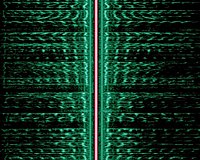Sideband
A graph of that concept, called a Fourier transform (or spectrum), is the customary way of visualizing sidebands and defining their parameters.This is sometimes called double sideband amplitude modulation (DSB-AM), but not all variants of DSB are compatible with envelope detectors.The receiver locally regenerates the subcarrier by doubling a special 19 kHz pilot tone.In another example, the quadrature modulation used historically for chroma information in PAL television broadcasts, the synchronising signal is a short burst of a few cycles of carrier during the "back porch" part of each scan line when no image is transmitted.In SSB, the carrier is suppressed, significantly reducing the electrical power (by up to 12 dB) without affecting the information in the sideband.This makes for more efficient use of transmitter power and RF bandwidth, but a beat frequency oscillator must be used at the receiver to reconstitute the carrier.Amateur radio and public service FM transmitters generally utilize ±5 kHz deviation.To accurately reproduce the modulating waveform, the entire signal processing path of the system of transmitter, propagation path, and receiver must have enough bandwidth so that enough of the sidebands can be used to recreate the modulated signal to the desired degree of accuracy.In a non-linear system such as an amplifier, sidebands of the original signal frequency components may be generated due to distortion.


Side projectcarrier frequencyfrequenciesmodulationspectral componentscross-correlationFourier transformFrequencyAmplitude modulationcarrier signalradio frequencybandwidthradio spectrumtransmissionsynchronous detectorenvelope detectorsDSB reduced-carrierreceiversynchronisephase-locked loopdouble sideband with suppressed carrierstereophonicFM broadcastingsubcarrierpilot tonequadrature modulationCostas loopspectrogramvestigial sidebandtelevisionbroadcastingsingle-sideband modulationshortwave radiocarrier is suppressedelectrical powerbeat frequency oscillatortransposerFrequency modulationmodulation indexCarson's ruleinterfereadjacent channelsfiltersbroadcast bandsubcarrierspercentagedeviationchannelAmateur radiofuzzboxIndependent sidebandOut-of-bandSide lobeSideband computingTV transmitterpublic domain materialGeneral Services AdministrationMIL-STD-188Department of The ArmyTelecommunicationsHistoryCable protection systemCable TVData compressionDigital mediaInternet videoonline video platformsocial mediastreamingEdholm's lawInformation AgeInformation revolutionInternetMobile phoneSmartphoneOptical telecommunicationOptical telegraphyPhotophonePrepaid mobile phoneRadiotelephoneSatellite communicationsSemaphorePhryctoriaSemiconductordeviceMOSFETtransistorSmoke signalsTelecommunications historyTelautographTelegraphyTeleprinterTelephoneThe Telephone CasesdigitalVideotelephonyWhistled languageWireless revolutionNasir AhmedEdwin Howard ArmstrongMohamed M. AtallaJohn Logie BairdPaul BaranJohn BardeenAlexander Graham BellEmile BerlinerTim Berners-LeeFrancis BlakeJagadish Chandra BoseCharles BourseulWalter Houser BrattainVint CerfClaude ChappeYogen DalalDaniel Davis Jr.Donald DaviesAmos DolbearThomas EdisonLee de ForestPhilo FarnsworthReginald FessendenElisha GrayOliver HeavisideRobert HookeErna Schneider HooverHarold Hopkins